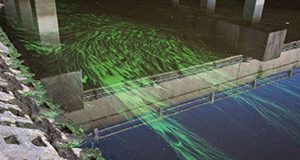Abstract
Microscopic algae in oceans and inland waters sometimes grow to excessive levels called “blooms.” Warmer water temperatures and increased nutrient levels exacerbate blooms, and when nutrients are high, temperature increases of just a few degrees cause exponential increases of algae and blooms. This 4-page fact sheet written by Karl Havens and published by the Florida Sea Grant College Program and UF/IFAS Extension explains why algal blooms can be harmful and provides advice for communities seeking to reduce nutrient levels in their lakes, streams, and other bodies of water. In a warmer future, harmful algal blooms will be much more challenging to control than they are today.
http://edis.ifas.ufl.edu/sg153
References
Florida Fish and Wildlife Commission. "Red Tides." http://myfwc.com/research/redtide/
Havens, K. E. 2012. Effects of climate change on the eutrophication of lakes and estuaries. SGEF-189. Gainesville: University of Florida Institute of Food and Agricultural Sciences and Florida Sea Grant College Program. http://edis.ifas.ufl.edu/sg127
Havens, K. E. 2015. Climate change and the occurrence of harmful microorganisms in Florida’s ocean and coastal waters. SGEF216. Gainesville: University of Florida Institute of Food and Agricultural Sciences and Florida Sea Grant College Program. http://edis.ifas.ufl.edu/sg136
Havens, K. E., and T. Frazer. 2012. Rethinking the role of nitrogen and phosphorus in the eutrophication of aquatic ecosystems. SGEF-190. Gainesville: University of Florida Institute of Food and Agricultural Sciences and Florida Sea Grant College Program. http://edis.ifas.ufl.edu/sg118
Havens, K. E., M. V. Hoyer, and E. J. Phlips. 2016. Natural climate variability can influence cyanobacteria blooms in Florida Lakes and Reservoirs. SGEF-234. Gainesville: University of Florida Institute of Food and Agricultural Sciences and Florida Sea Grant College Program. http://edis.ifas.ufl.edu/sg142
Havens, K. E., G. Ji, J. R. Beaver, R. S. Fulton III, and C. E. Teacher. 2017. "Dynamics of cyanobacteria blooms are linked to the hydrology of shallow Florida lakes and provide insight into possible impacts of climate change." Hydrobiologia, DOI: 10.1007/S10750-017-3425-7
Havens, K. E., and H. W. Paerl. 2015. "Climate change at a crossroad for control of harmful algal blooms." Environmental Science and Technology, DOI 10.1021/acs.est.5b03990.
Paerl, H. W., W. S. Gardner, K. E. Havens, A. R. Joyner, M. J. McCarthy, S. E. Newell, B. Qin, and J. T. Scott. 2015. "Mitigating cyanobacterial harmful algal blooms in aquatic ecosystems impacted by climate change and anthropogenic nutrients." Invited Review, Harmful Algae, Online: http://dx.doi.org/10.1016/j.hal.2015.09.009
Paerl, H. W., T. Scott, M. J. McCarthy, S. Newell, W. S. Gardner, K. E. Havens, W. Wurtsbaugh, and S. W. Wilhelm. 2016. "It takes two to tango: why dual nutrient (N&P) reductions are now the rule rather than the exception for eutrophication and harmful algal bloom control along the freshwater to marine continuum." Environmental Science and Technology, DOI 10.1021/acs.est.6b02575.
Unless otherwise specified, articles published in the EDIS journal after January 1, 2024 are licensed under a Creative Commons Attribution-NonCommercial-NoDerivs 4.0 International (CC BY-NC-ND 4.0) license.

